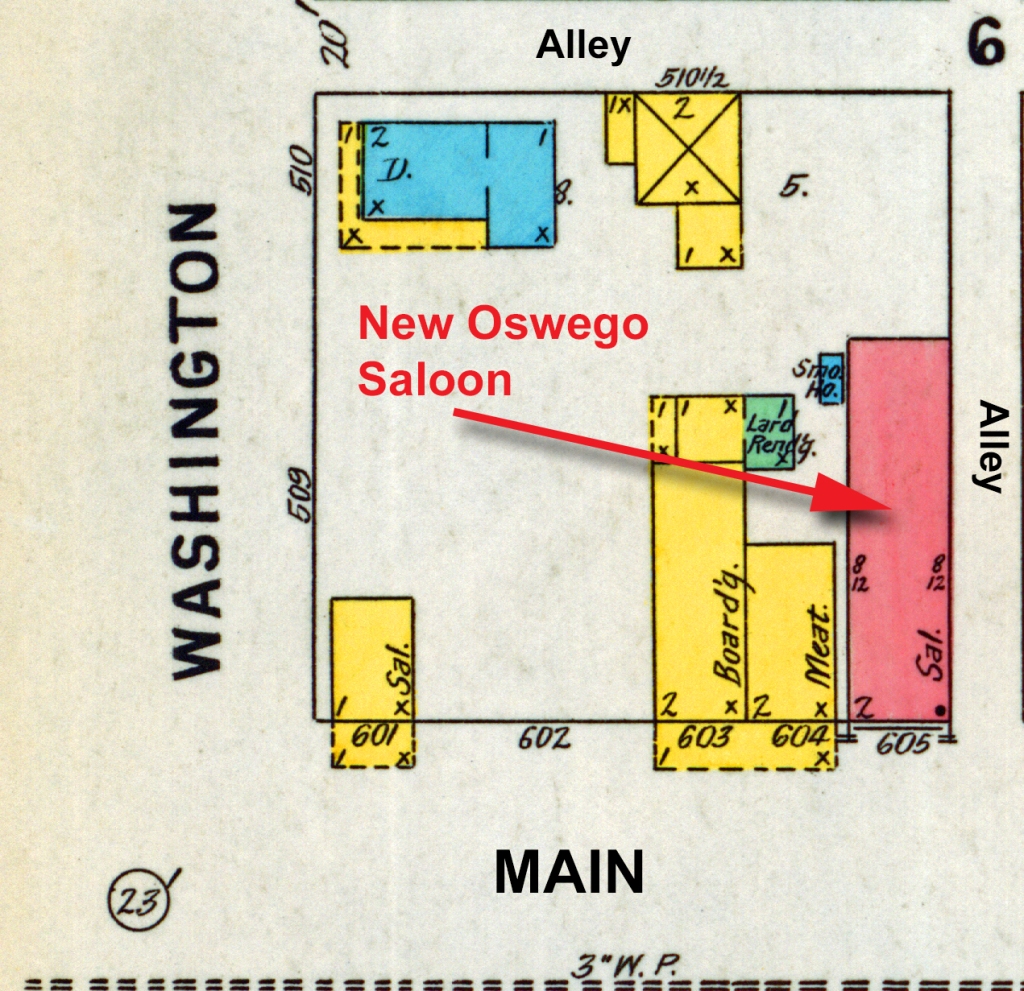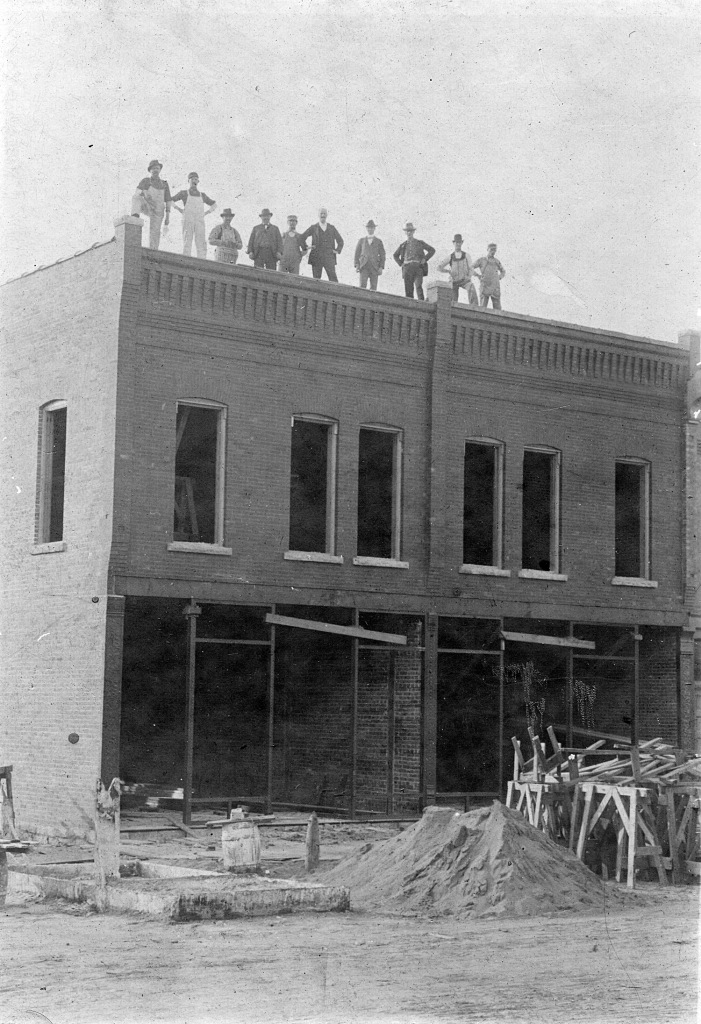Look at the buildings in Oswego’s small downtown business district, and they look so solid you get the impression they’ve always been there. Which, of course, they haven’t—everything was new at one time or another, even those familiar downtown storefronts.
Throughout the years, I’ve done quite a bit of research on individual aspects of Oswego. I’ve decided to get as much of it as possible down and available online to anyone interested. Because as we all know—or should know—the stuff you post online is forever.

I previously sketched the histories of the landmark Union Block and Rank Building on the east side of Main Street. This week, I figured I’d mosey across the street and look at the histories of the Oswego Saloon and adjoining Knapp Building. Today, the Knapp Building houses the Masonic Hall and the Oswego Family Restaurant, while the old Oswego Saloon is the location of the Happenstance Goods antique store.
“Oswego Saloon?” I imagine you’re wondering. And yes, a major downtown building originated as a saloon. And not just any saloon, either, but arguably the most elegant watering hole in town.
Saloons in the late 1800s were important to municipalities throughout northern Illinois because they generated license revenue. This was the era before municipalities were allowed to levy real estate or sales taxes. The only municipal revenue sources were fines for violating village ordinances generated by local justices of the peace—and the aforementioned saloon licenses, plus billiard table licenses.

In fact, the revenue from Oswego’s saloons—there were at least two, often three in town—financed the village’s first municipal water system, including the elevated tank and water mains, along with the equipment for its first fire brigade and the first system of concrete sidewalks.
That municipal revenue was one reason prohibition of alcohol was such a hard sell. Saloon licenses were set at $1,000 per year in the late 1890s, which amounts to about $34,000 in 2024 currency, before being lowered to $750 in the late 1890s after some of those improvements had been paid off.
And please note, today’s Oswego Inn at Main and Jackson, formerly Johnson’s Tavern, did not exist until the first third of the 20th Century after Prohibition ended.

Oswego’s 19th Century saloons were all located on the west side of Main Street between Washington and Jackson, in a stretch of frame and limestone storefronts that resembled, more than anything else, one of the cow towns out west of the Mississippi. By the 1890s, those buildings were showing their age, and both in-town and out-of-town business owners were thinking about replacing the old buildings with new, modern ones.
On Oct. 19, 1897, the Kendall County Record’s Oswego correspondent, Lorenzo Rank, reported: “The Schroeder saloon building is being demolished by Aurora parties to whom it belongs and a new one will be erected in the place of it.” The building fronted on Main Street and bordered the south side of the alley that ran east to west across Main Street between the Union Block and Rank’s Oswego Post Office on the east side of the street.
The new building was designed with elements of the old Italianate style, but it also included some more modern Eastlake design elements, creating an interesting transitional style all its own. It was the first major building project downtown since the Star Roller Skating Rink had been completed across the street from the new saloon back in 1885. The frame rink building was situated on the lot north of Rank’s Oswego Post Office building on the site of the old National Hotel that burned with everything else on that side of Main Street in February 1867.

On Nov. 3, Rank reported construction on the new saloon was moving forward at a brisk pace. “The new brick building, which is to be built of the most modern style of architecture and finish, will be the pride of the town,” he wrote. “We folks who have been in the habit of saying that ‘saloons are no good’ will have to dry up. The building is about ready for the roof.”
Not everyone in town was impressed with the new saloon—or any saloons for that matter. In February as the building was nearing completion, Margaret Phillips Young, president of the Oswego unit of the Women’s Christian Temperance Union, caustically complimented the people of Oswego, noting that, among other things, they maintained four churches for salvation, and three saloons for damnation.
As completed, the building featured the modern saloon on the first floor and an apartment above.
On March 23, Rank noted the building’s interior decoration was nearly completed, and—although himself a teetotaler—was so overawed at the saloon’s beauty he was almost unable to express himself: “J.A. Schmidt and Ira Ackley have been doing the decorating of the new saloon building, all of which is most magnificent. Every room is of different color and pattern. The wine room—well, gorgeous or splendid—fail to express the sight of it,” he wrote.
The saloon opened for business in May 1898. In his May 4 “Oswego” column in the Record, Rank wrote: “Michels and Conway Sample Rooms was artistically painted on the large plate-glass of the new saloon Monday, which had opened for business in the morning.”
Since that opening, the building has been the site of numerous businesses through the years, including the All-American Male men’s wear store. Currently, as noted above, it’s the site of the Happenstance Goods antique store.

While the Oswego Saloon’s construction was underway, Oswego businessman and property investor Charles Knapp was busy planning an even larger building on the two lots adjoining the saloon site to the south.
On Oct. 20, 1897, Rank reported in his “Oswego” news column that: “The fall weather thus far has been most opportune for building purposes. It is said that if it could be depended upon for a month longer, two more or rather a double brick building for stores below and hotel above would be constructed adjoining the one now on building, and thus making a solid brick block of 66 feet frontage. It will be accomplished early in the spring if not sooner. Charles Knapp will have it done having secured the Troll premises for the enterprise.”

The new building would also be built in the same fashionable Eastlake style as Knapp’s home on Adams Street.
George Troll was a long-time saloon owner in downtown Oswego who was doing business in one of the frame buildings where Knapp planned to build his new two-storefront building. Knapp himself was the owner of the meat market in the other adjoining building slated for demolition and replacement with a new brick building.

Knapp was a German immigrant who had been engaged in the livestock and related meat market business in Oswego for more than two decades. Mostly he worked in partnership with Henry Wollenweber. The partnership of Wollenweber & Knapp owned acreage north of Washington Street between Adams Street and the Fox River where they grazed cattle, and also maintained the Oswego Stockyards between North Adams at the railroad tracks north of Jackson Street. They also owned a slaughterhouse north of Waubonsie Creek. They annually shipped thousands of head of cattle and hogs to market that had been driven into town by farmers in the surrounding countryside. During 1880, for instance, the firm shipped 108 railcar loads of hogs and cattle from Oswego.

Knapp also built a home in the Eastlake style adjacent to his grazing land at the northwest corner of Jackson and Adams streets. The home stood until it was demolished in recent years to make room for a new apartment block.
On June 22, 1898, Rank reported from Oswego that: “The Knapp buildings are nearly completed and now receiving the finishing touches. The metallic ceiling of the hall and rooms connected with it are made dazzling by paint.”
After the building’s completion, George Croushorn moved his furniture business into the south storefront. Croushorn was also the village’s undertaker. Knapp owned the meat market in the north storefront, although it was managed by a number of butchers through the years. James Malcolm eventually bought the meat market from Knapp and ran it for many years.

The Knapp and Saloon buildings housed a number of businesses through the years. The saloon was put out of business when Prohibition, first local and then nationwide, came in, while the Knapp Building housed various businesses until it was purchased by Oswego Masonic Lodge 303, AF&AM in 1924. Since then, the north storefront has housed a number of restaurants—currently the popular Oswego Family Restaurant is doing a lively breakfast and lunch business there—while the Masons use the upstairs of the building as their meeting rooms and the downstairs north storefront as a hall where hundreds of public events have taken place through the years.
Today—some 126 years after their construction—the two buildings, although their storefronts have been modified and “updated” through the years (unfortunately losing their distinctive cast iron fronts in 1958), still stand as viable and familiar landmarks in Oswego’s historic downtown Main Street business district.
